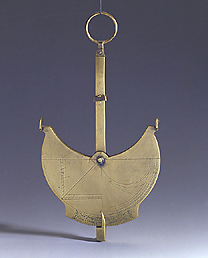
 |
| Catalogue |
 |
 Navicula Dial The instrument appears to be unfinished. None of the divisions or hour scales are numbered, the latitude values have not been placed on the mast, the divisions of the solar declination scale have not been indicated, and the final divisions at each end of the zodiac scale have not been engraved. Since the instrument is generally rather well-constructed (despite some carelessness in the division of the zodiac scale), this unfinished state is presumably the result of the work having been interrupted. The instrument is one of a very small number of surviving instruments of this type. Known examples are preserved in Oxford, Museum of the History of Science, Lewis Evans collection, early to mid-15th century; Greenwich, National Maritime Museum, early to mid-15th century; Geneva, Mus?e d'Histoire des Sciences, early to mid-15th century; Milan, Museo Poldi Pezzoli signed 'Op{us} ORONTIF{INAEI} 1524' ; and Cambridge, Whipple Museum of the History of Science, signed 'S F 1620' . To these may be added three further examples now lost. These are Colchester, in the possession of one 'W. B.' who published an engraving and description of it in the Gentleman's Magazine for January 1787; London, The Science Museum, Lost, no details available; and London, The British Museum, destroyed during the war of 1939-45, signed 'Arc/enii Coloniae fererunt anno 1581', (Ex Spitzer Collection No. 2912). When compared with these, the present instrument shows three features which are without parallel on the others, the full zodiacal calendar drawn on the two sides of the instrument, the subdivision of the hours to twenty minutes, and the grid below the unequal hour diagram. On all other examples either a date scale or a zodiac scale is drawn below the hour diagram. None of them have a complete zodiacal calendar whether on one or both sides. On no other known example of the instrument is there a grid drawn between the unequal hour diagram on the back and the degree scale marked on the limb. This grid seems to be intended for a zodiac scale for use with the unequal hour diagram. Subdivision of the hours into thirds is also absent from surviving instruments although it described in the anonymous Latin treatise contained in Bodley Ms 68. This is of interest since Kragten has shown that in its construction the Florence dial conforms to the instructions contained in this text, whereas the Oxford, Milan and Cambridge dials show influence derived from the tradition that gave rise to the construction of universal rectilinear dials in the way that Regiomontanus described in c. 1474 . Both the date and the localisation of this instrument are problematical. Neither the 1954 Catalogue nor Bonelli offered either a date or a place of origin, Miniati suggests 16th century and 'probably German', Brusa 'probably German and circa 1600?'. Dates as late these however seem highly unlikely for the neat, well-executed Gothic scrip used for the month and zodiac sign names in the zodiacal calendar. This would be more compatible with a 15th century date. Although the dial differs in layout from the other four early to mid-15th century instruments, the contractions for the names of the zodiac signs are different, and a capital 'A' for Aries is used rather than lower case, the actual form of the lower-case letters on all five instruments is not dissimilar. Thus, although representing a different tradition of design, the present instrument may originate from the same area as the other known 15th century dials of this type which is England, perhaps in its North Easterly regions. Anthony J. Turner |



